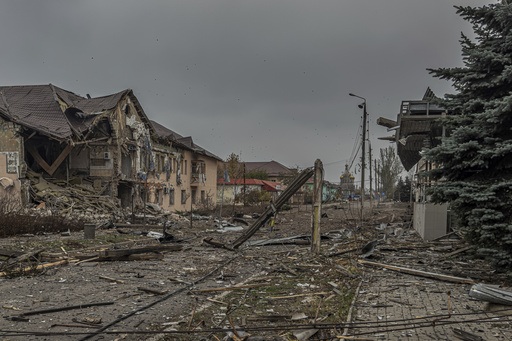
KURAKHOVE, Ukraine — Nestled at the eastern frontline of Ukraine, Kurakhove is precariously situated, surrounded on three sides by Russian forces that are encroaching within two miles (3 kilometers) of the city’s ravaged center.
Despite the escalating conflict, approximately 700 to 1,000 residents have chosen to remain, mostly taking refuge in the basements of their apartment buildings, deprived of essential services like running water, heating, and electricity. The basement of the structure currently serving as the city administration has become the sole location for residents to recharge their mobile phones.
Determining an exact population count has been challenging, especially since humanitarian volunteers have not been seen in Kurakhove since mid-October. Under relentless assault from artillery bombardments, multiple rocket launcher strikes, aerial bombardments, and drone attacks, Kurakhove has transformed into a contemporary battlefield, echoing the fate of Bakhmut as Russian troops advance westward, with ambitions to seize full control of the Donbas region. Recently, President Volodymyr Zelenskyy described the circumstances in Kurakhove and the vital city of Pokrovsk as “the most challenging.”
The local infrastructure has faced devastating blows, with hospitals, schools, kindergartens, the water treatment plant, a refugee center, a post office, a technical school, and a cultural center all reduced to rubble. A pall of smoke lingers over the area as burnt-out residential buildings smolder under a constant barrage of artillery fire and drones.
Artillery units from the 33rd Brigade report that they fire around 50 shells daily aimed at the Kurakhove front, underscoring the heightened activity of Russian offensive maneuvers and the brigade’s desperate efforts to thwart the encirclement of the city.
Local authorities, along with representatives from the police and Territorial Defense Forces, continue to operate from the city, though hope seems to be dwindling. Artem Shchus, the head of police in Kurakhove, expresses skepticism about the possibility of defending the city if it becomes completely surrounded. “Given the reality of modern warfare and the available technologies, the logistics would essentially need to rely solely on drones,” he remarks.
The route to Kurakhove, marked by charred civilian vehicles, is grimly dubbed the “road of death” by locals, a reference to the ongoing drone assaults launched by Russian forces. Tragically, five civilians have lost their lives trying to escape via this dangerous route.
Vital supplies still reach Kurakhove, thanks to a group known as the “White Angels,” which consists of local police officers and volunteers who deliver medical assistance and retrieve the deceased from bombings. They also manage the city’s only operational food store. Operating in an armored vehicle outfitted with electronic warfare technology, the White Angels undertake risky missions to ferry essential supplies into the beleaguered city.
“Going without jammers is basically a gamble. With them, you might have a chance at survival,” explains Shchus. For residents seeking to vacate the city, the only safe option is to accompany the White Angels, who face the daily peril of evacuating six to twelve individuals from various areas of Kurakhove and the surrounding villages.
While children are officially designated for evacuation, many parents attempt to hide them from both the conflict and law enforcement. A primary goal for the White Angels is locating these children and encouraging their families to leave. When successful, the reactions of children to the devastated urban landscape indicate they have been hidden away for some time.
Once equipped with protective vests and helmets, the children are transported to Kostyantynopil, where other volunteers assist in directing them to refugee registration centers in Dnipro or Zaporizhzhia.
“We continuously evacuate individuals day in and day out. We just delivered people to Kostyantynopil today and have further addresses to attend to,” Shchus elaborates. As he reflects on the adjustment to working in such perilous conditions, Shchus expresses concern for his team’s mental well-being. “I believe everyone has adapted in some sense, though I wouldn’t label it adaptation. It feels more like a state of mind that isn’t particularly healthy. I worry about how this might affect them socially in the long run,” he shares. “These individuals endure inhumane conditions and survive largely on adrenaline. The war dictates their lives. The circumstances are extremely challenging, but everyone remains committed to their work.”
